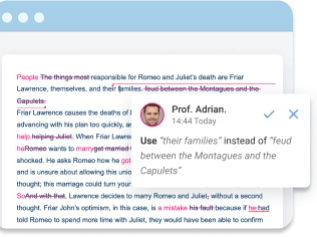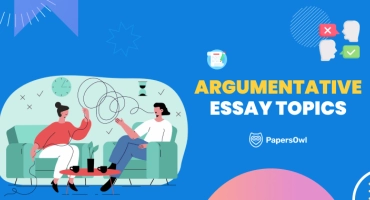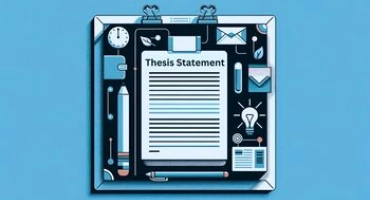Argumentative Essay Conclusion Examples and Writing Guide
Table of contents
- 1 What to Write in the Conclusion for an Argumentative Essay
- 2 Step-by-Step Guide to a Good Conclusion
- 3 How to Restate a Thesis Statement in Writing?
- 4 Formatting and Structure Tips for Conclusions
- 5 How to Finish a Conclusion Paragraph Argumentative Essay
- 6 Conclusion Examples by Essay Type
- 7 Final Thoughts and Call to Action
Struggling with how to end an argumentative essay? You’re not alone. Writing a solid conclusion can be tough, especially when you’re low on energy. But it’s key to your writing impact.
A good conclusion should briefly restate your thesis statement and your main argument, summarize the evidence presented, address opposing viewpoints, and leave a strong conclusion that sticks with your reader — and even influences public opinion. You might also mention counterarguments in your writing to show depth.
In this guide, you will learn how to write a good conclusion for an argumentative essay. It will help you tie everything in your writing together with confidence.
What to Write in the Conclusion for an Argumentative Essay
A strong conclusion of writing should do more than just restate your main points and arguments. It should drive your argument home and leave a lasting impression.
Start writing by clearly reiterating your thesis and summarizing the evidence you’ve discussed. Keep writing briefly, but make sure the message is evident. Then, acknowledge any opposing viewpoints you addressed. It will show a balanced and thoughtful discussion.
It’s imperative to keep your tone of writing confident yet calm, like you’re giving a well-crafted speech. Mention why your topic matters in real life, and suggest further exploration. This keeps your conclusion relevant and forward-thinking.
End with hopeful or impactful points that make the reader reflect on your arguments or take action. Never introduce new arguments here — this is where you point home what’s already been said.
If you’re stuck or unsure how to finish strong, getting paper help can assist you in polishing your article without the stress.
Step-by-Step Guide to a Good Conclusion
🔹 STEP 1: Reaffirm the Relevance
🔍 Explain why your topic matters today.
“With rising global temperatures and environmental disasters, climate change is no longer a future threat but a current crisis.”
🔹STEP 2: Restate Your Thesis with Purpose
🔁 Paraphrase your thesis using new language while preserving the core idea.
🔹STEP 3: Emphasize Key Findings
📌 Highlight the strongest points of evidence from your body paragraphs.
🔹STEP 4: Address the Bigger Picture
🌍 Connect your topic to societal, political, or future implications.
“If left unchecked, digital misinformation could erode democratic institutions and public trust.”
🔹 STEP 5: End with a Call to Action or Thought-Provoking Statement
🎯 Encourage readers to think, act, or continue exploring the issue.
Need help wrapping up your writing with polish? Our argumentative essay writing services can make your final paragraph shine.
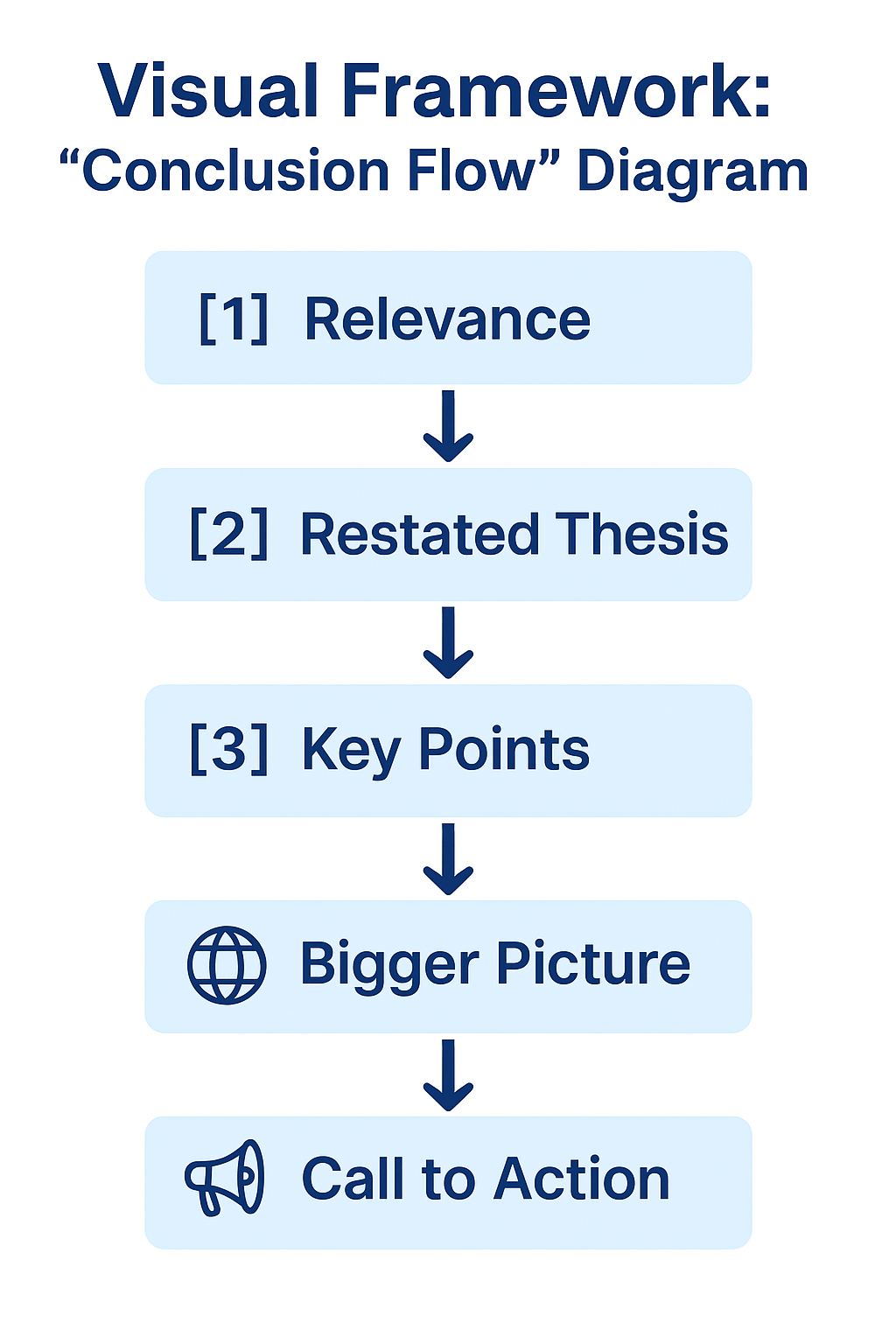
How to Restate a Thesis Statement in Writing?
A good conclusion starts by effectively restating your thesis statement. Instead, briefly restate the claim with a deeper impact now that your readers know the full discussion.
- ✅ Choose the Right Spot
Place your restated statement where it flows best — usually at the beginning of the conclusion. Or try opening with a compelling question, depending on your paper’s tone.
- ✅ Avoid using the same language as your introduction.
Your conclusion of writing should echo the tone of your introduction, creating a balanced structure.
- ✅ Reflect on Your Findings
Reflect on your findings to make a deeper case. Use the full context of your writing and research to reshape your argument. Highlight the importance of your main points and connect them to broader viewpoints.
- ✅ Clarify the “So What?”
Address why your argument matters. Note its real-world value and answer the reader’s unspoken “Why should I care?” with a clear point.
- ✅ Avoid Clichés and Mistakes
In your writing, skip overused phrases like “In conclusion.” They weaken your statement. Also, don’t present new arguments or claims.
- ✅ Balance Confidence and Respect
Be confident in your argument, but acknowledge opposing viewpoints. This shows maturity and strengthens your overall discussion.
- ✅ Finish Strong
Your final sentence should leave a compelling impression. Whether it’s a hopeful thought or a call to action, make it count. Encourage the reader to reflect on your arguments.
By mastering this structure, you’ll learn how to conclude your essay with purpose and impact.
Formatting and Structure Tips for Conclusions
A well-structured conclusion reinforces your thesis statement and ties together all the key points of your paper. Beyond content, proper formatting ensures your argument is taken seriously in academic settings. A well-formatted conclusion reinforces your thesis and strengthens your argument.
✅ Basic Formatting Guidelines:
- Font: 12-point Times New Roman
- Spacing: Double-spaced (275 words/page) or single-spaced (550 words/page)
- Margins: 1″ on all sides
- Indentation: First line 0.5″, no extra spacing between paragraphs
✅ Structuring a Clear and Compelling Conclusion:
- Begin with a thoughtful lead — a reflective first sentence or question that sets the tone.
- Briefly restate your thesis with a fresh perspective now that your main points are clear.
- Highlight the significance of your findings and connect them back to your introduction.
- Address any opposing viewpoints to show depth and credibility in your discussion.
- Conclude with a strong statement — an idea that resonates, encourages further research, or underscores the importance of your argument.
For a complete walkthrough on writing impactful essays, explore our full guide to writing a perfect argumentative essay.
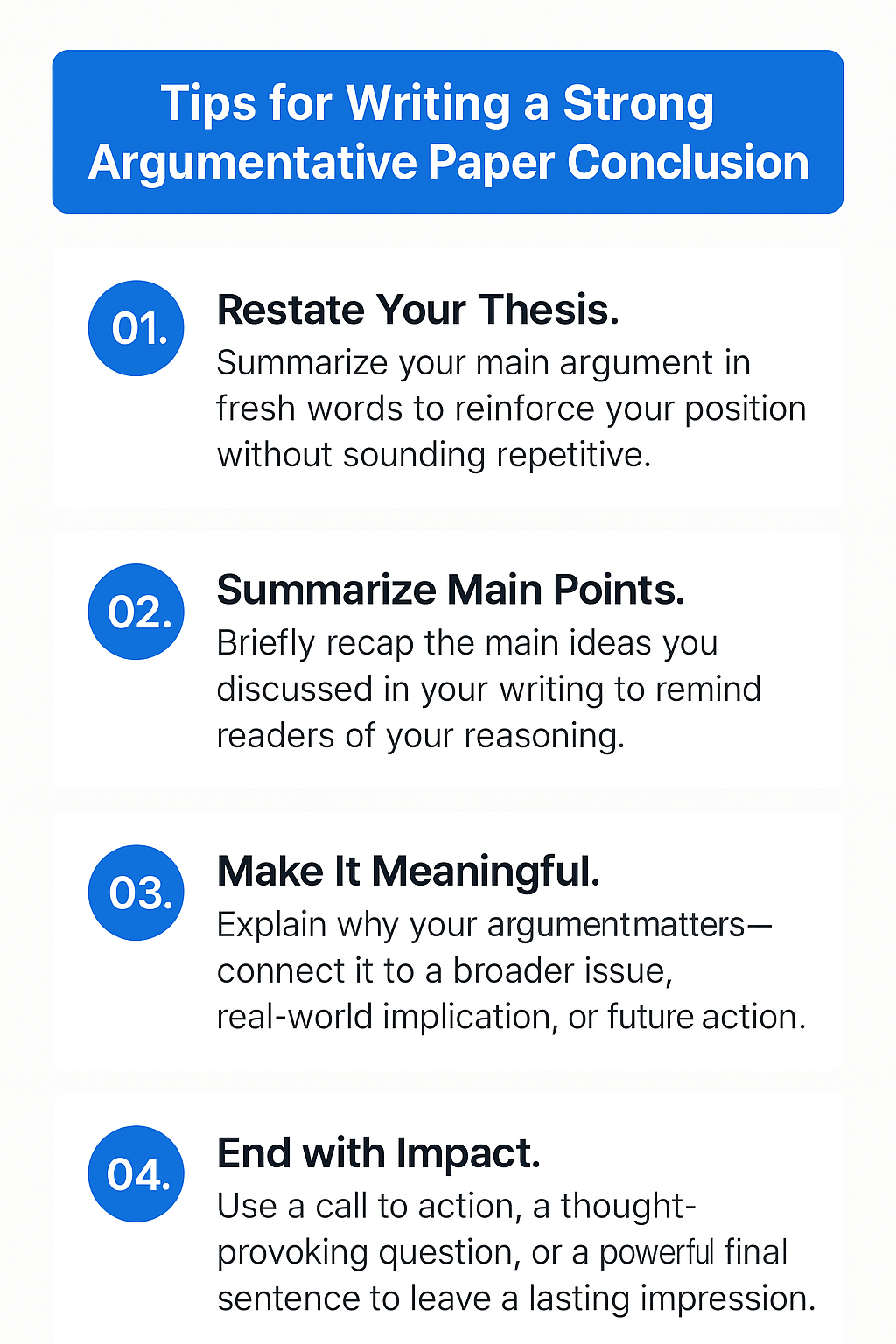
How to Finish a Conclusion Paragraph Argumentative Essay
Writing a conclusion for argumentative essay is all about clarity, impact, and tone. Here’s a step-by-step guide to help you do just that — and if you’re ever short on time, you can pay for essay help from professionals.
🔷 The RISE Method for Writing Conclusions for Argumentative Essays
A clear and actionable 4-step method to help students with writing impactful conclusions for papers that do more than just summarize.
- 🟡 R – Restate the Thesis
Rephrasing your thesis helps reinforce the importance of your paper topic. Keep the core message intact, but change the sentence structure and vocabulary to avoid repetition. Restate your argument confidently to emphasize your position.
📌 Original Thesis: Social media harms mental health among teenagers.
Restated: The mental well-being of today’s youth continues to be harmed by the growing influence of social media platforms.
- 🟡 I – Integrate Key Arguments
Summarize the main points from your body paragraphs, highlighting how they support your thesis. Keep this part of the writing concise and logical.
📌 From increased anxiety to poor sleep habits and distorted self-image, each argument underscores the urgent need to reassess teens’ social media use.
- 🟡 S – Suggest Broader Implications
Go beyond the paper. Show the reader why your argument matters in a broader context — socially, politically, academically, etc.
📌 Left unaddressed, the mental health challenges linked to social media may contribute to long-term societal issues like rising healthcare costs and decreased academic performance.
- 🟡 E – End with a Call-to-Action or Reflection
Finish your writing with a powerful final thought — a suggestion, question, or reflection that invites the reader to think, feel, or act. Remind readers of the importance of your argument in today’s world.
📌 As digital platforms continue to shape young minds, it’s crucial for parents, educators, and tech developers to collaborate on creating healthier online environments.
🧩 RISE Conclusion Template for Argumentative Essays
💡 Use this plug-and-play format for writing a powerful conclusion. Replace the [brackets] with your topic-specific information.
R – Restate the Thesis:
It is clear that [restate your thesis in different words — same core idea, new phrasing], showing the importance of [main subject of the paper].
I – Integrate Key Arguments:
Throughout the paper, evidence has shown that [briefly list 2–3 major arguments or main points you made], all reinforcing the need for [your main position].
S – Suggest Broader Implications:
This issue extends beyond individual circumstances, as [explain the broader impact or consequence — societal, educational, political, etc.].
E – End with a Call-to-Action or Reflection:
Moving forward, [propose a solution, ask a reflective question, or call for action] to ensure [desired outcome or impact related to your topic].
📝 Full Example: Argumentative Conclusion Using the RISE Method
Topic: Should school uniforms be mandatory in public schools?
Mandating school uniforms in public schools is helpful. It creates a more focused learning environment. It promotes equality among students. It promotes respect among students. Uniforms minimize distractions related to clothing. Uniforms remove visible markers of economic differences. This helps level the playing field. Uniforms make morning routines easier for students. Uniforms make morning routines easier for parents. Uniforms help reduce bullying based on appearance. These policies build a stronger sense of community. They encourage school pride. Social pressures are common today. Inequality is common today. Mandatory uniforms offer a practical step toward inclusivity. Mandatory uniforms offer a practical step toward academic success. Educators should support this reform. Policymakers should support this reform. This reform is simple. This reform is effective.
📌 Final Paragraph Checklist
Before you submit your writing, make sure your conclusion includes:
✅ A clear restatement of your thesis in new words;
✅ A summary of your main points;
✅ A sense of closure and completeness;
✅ A link back to the paper’s broader significance;
✅ A final sentence that is memorable and action-oriented;
✅ A consistent tone that matches the rest of the paper;
✅ A section that briefly summarizes your body points;
✅ The last mention of your core thesis without introducing new ideas.
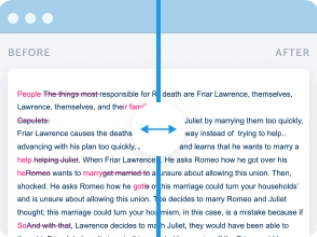
Conclusion Examples by Essay Type
If you are still trying to figure out what your writing should look like, check conclusion examples for argumentative essay below. We have prepared how-to-end argumentative essay examples. These can give you an idea about the structure and format of your argumentative paper’s final point.
Conclusion Paragraph Examples for Argumentative Essay
Argumentative Essay Conclusion Example #1:
Topic: Should school uniforms be mandatory in public schools?
Mandating school uniforms in public schools is helpful. It creates a more focused learning environment. It promotes equality among students. It promotes respect among students. Uniforms minimize distractions related to clothing. Uniforms remove visible markers of economic differences. This helps level the playing field. Uniforms make morning routines easier for students. Uniforms make morning routines easier for parents. Uniforms help reduce bullying based on appearance. These policies build a stronger sense of community. They encourage school pride. Social pressures are common today. Inequality is common today. Mandatory uniforms offer a practical step toward inclusivity. Mandatory uniforms offer a practical step toward academic success. Educators should support this reform. Policymakers should support this reform. This reform is simple. This reform is effective.
Argumentative Essay Conclusion Example #2:
Topic: Social media does more harm than good
The harmful impact of social media on mental health, privacy, and misinformation cannot be overlooked. As shown through rising depression rates and digital exploitation, its drawbacks outweigh the benefits. Society must rethink its relationship with these platforms. Stricter regulations and user education are vital to safeguarding our well-being in the digital age.
Argumentative Essay Conclusion Example #3:
Topic: College should be free for everyone
Making college tuition-free would create a more equitable society and boost economic mobility. This writing has explored how debt discourages education, how free tuition increases graduation rates, and how it benefits the economy. Universal access to education empowers individuals and strengthens nations. It’s time for governments to invest in the future through free college.
Argumentative Essay Conclusion Example #4:
Topic: Animal testing is unethical
The continued use of animals in testing is an outdated practice that causes unnecessary suffering. Scientific advancements offer ethical alternatives, like in vitro testing and computer modeling. As society evolves, so should its standards of compassion. Ending animal testing is not only humane but scientifically responsible.
As you can see, some good argumentative essay topics need an emotional appeal to the reader. It’s important to present your views and arguments effectively and respectfully. Meanwhile, no matter your point, it is crucial to note your ideas without offending anyone else.
Conclusion Examples for Expository Essay
Expository Essay Conclusion Example #1:
Topic: How photosynthesis works
Photosynthesis is a complex yet essential process that sustains life on Earth. Plants provide oxygen and food for nearly all living organisms by converting sunlight into energy. Understanding this process helps us appreciate the delicate balance of our environment and the vital role plants play in our ecosystem.
Expository Essay Conclusion Example #2:
Topic: The process of applying to college
Applying to college involves several key steps: researching schools, preparing applications, and meeting deadlines. Though the process can be stressful, breaking it down into manageable parts makes it more achievable. With preparation and support, students can navigate the application journey with confidence.
Conclusion Examples for Compare & Contrast Essay
Compare & Contrast Essay Conclusion Example #1:
Topic: Online learning vs. traditional classroom learning
While both online and traditional learning environments have advantages, they cater to different needs. Online learning offers flexibility and accessibility, while classroom learning fosters in-person interaction. Choosing the best option depends on a student’s goals, learning style, and resources.
Compare & Contrast Essay Conclusion Example #2:
Topic: Renting vs. buying a home
Renting provides short-term flexibility and lower upfront costs, whereas buying builds equity and offers long-term stability. Each option suits different life stages and financial goals. Ultimately, the best choice aligns with individual priorities and future plans.
Critical Analysis Essay Conclusion Examples
Critical Analysis Essay Conclusion Example #1:
Topic: Analyzing the theme of ambition in Macbeth*
Shakespeare’s Macbeth presents ambition as both a powerful motivator and a destructive force. Macbeth’s rise and fall reflect how unchecked ambition can corrupt even the noblest of characters. This analysis reveals that ambition leads to inevitable downfall when pursued without morality.
Critical Analysis Essay Conclusion Example #2:
Topic: Evaluating the film The Social Network*
The Social Network offers more than just a retelling of Facebook’s creation — it critiques ambition, betrayal, and the cost of innovation. Through its sharp dialogue and character arcs, the film highlights the ethical dilemmas of the digital age. It serves as both a biography and a cautionary tale for modern tech entrepreneurs.
Final Thoughts and Call to Action
Mastering how to conclude an argumentative essay is very important. It is just as crucial as writing a compelling introduction. It is also as important as writing strong arguments throughout your paper. A well-written conclusion does more than briefly restate your thesis. It reinforces your main points. It highlights the importance of your findings. It ties your writing together with impact.
When you conclude your writing, make sure to reflect on the point you’ve made and present a meaningful answer or insight that resonates. This part of the writing is your chance to inspire hope, suggest future directions, and mention the broader value of your work.
Need help on how to write a conclusion paragraph for an argumentative essay? Our expert writers at PapersOwl can help finalize your paper with clarity and confidence. Whether you’re short on time or just need a second pair of eyes, we’re here to help.
